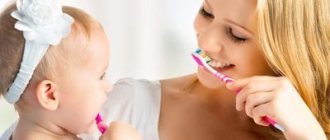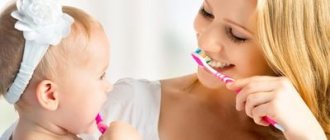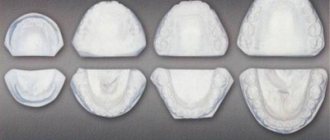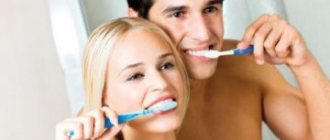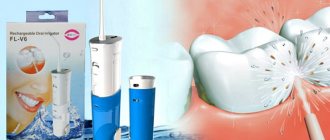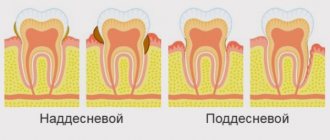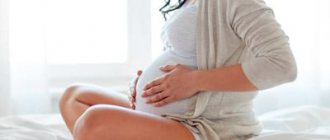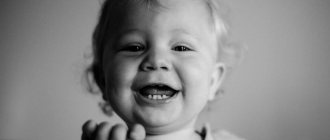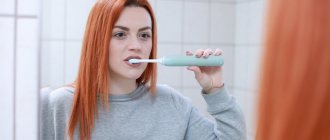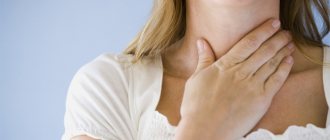To maintain dental health at any age, daily oral hygiene is extremely important. It would seem a simple procedure that does not take much time and does not require any extraordinary skills and efforts. But sometimes even adults are too lazy to do it regularly. What then can we say about kids? They don't even suspect such a need. How to teach a child to brush their teeth every day - morning and evening? What parenting tricks can you use to achieve the best results?
Baby 1 year old
At 1-2 years old, a child cannot yet brush his teeth on his own. But in order to develop a stable habit, this procedure can be carried out by parents until the baby grows up a little.
According to dentists, a child should start brushing his teeth when the very first ones have just erupted. For some it happens earlier, for others later.
But when the baby turns 1 year old, he definitely already has a couple of teeth in his mouth. And they require proper care. While the child does not know how to brush his teeth on his own, one of the parents does it for him using a special silicone brush.
Carry out this procedure regularly after your baby wakes up in the morning and before bed. This will be the initial stage of teaching a child to mandatory and regular brushing of teeth. And when your baby gets a little older, you can safely start teaching him to brush his teeth on his own.
How many times a day and for what time should you brush your teeth with your child?
To keep teeth attractive and healthy, children and adults need to brush at least 2 times a day – morning and evening. It is important to adhere to this regime constantly.
Some parents prefer to perform all manipulations immediately after their son or daughter wakes up. However, the surest option is to clean the surfaces after the little person has had breakfast. This will remove food particles remaining in the interdental spaces.
At the same time, there are certain nuances that moms and dads should remember. If children ate fruit or drank juice in the morning, hygiene procedures are postponed. This is due to the fact that the released fruit acids help to soften the enamel layer, and as a result, useful elements contained in the enamel can be removed along with soft deposits.
In any case, dentists recommend waiting at least half an hour after eating. This time is enough to restore the acid-base balance.
The correct duration of brushing
In order for each session to give the desired result, plaque and food debris are completely removed, and the components of the paste have time to act, you need to clean the oral cavity within a certain time interval. 3 minutes is the optimal period of time during which all soft deposits are eliminated, and the useful elements of hygienic compositions are most effective.
This indicator is relevant for any age. Of course, if the baby is still very small, he will not be able to endure a three-minute massage with a silicone tip. However, this is not necessary.
The duration of cleaning may increase or decrease if:
- diseases of the oral cavity and inflammatory processes;
- malocclusion and abnormalities in the structure of the jaws;
- wearing corrective structures.
Child 4-5 years old
By the age of 4-5, many toddlers have already developed a stable habit of brushing their teeth. And parents can begin to draw their attention to the quality of the procedure.
Be patient. You are unlikely to be able to immediately teach your child to take care of his teeth. And that's okay. Moreover, for several more years (approximately until the toddler reaches school age) you will have to control the process itself. Since the baby still cannot properly brush his teeth on his own.
Which toothbrush should you choose?
Children's toothbrushes, without exception, have soft bristles. It is distinguished from an adult brush by a smaller head, which can be rubberized, which is done to reduce the risk of injury during the cleaning process.
The packaging of most brushes for children contains information about the age they are intended for: these recommendations should not be neglected. It is better to choose a brush with an unusual design that can attract the child’s attention and make him more willing to brush his teeth.
The brush should be changed once every 3 months, or better yet more often: you need to monitor the condition of the bristles, and not hesitate to replace them when they begin to deteriorate. The point here is not only the lack of aesthetics, but also the loss of functional qualities: if the bristles are fluffy, then it will be difficult to remove plaque, which is fraught with unpleasant consequences.
Each family member should have their own brush!
Recently, electric toothbrushes have become increasingly popular. There are special children's brushes that can be used after 3 years. Practice shows that children show more interest in electric toothbrushes than in regular ones. Again, each child should have their own personal attachment.
Recommendations for parents
- Brushing your teeth should not be a routine task for your child. Let it be in a playful way. So that the baby wants to repeat the procedure again and again.
- At the initial stage of your child’s education, your priority is to develop a habit, and not to teach the correct manual skills (how to hold a brush and how to move it, how long to brush your teeth, etc.). First, the baby must understand the importance of what he is doing, become interested, be inspired, and only then begin to follow the process itself.
- Therefore, after your little one brushes her teeth, be sure to check the result and clean them. Explain that not all evil caries were driven away by the child. Next time, let him try to reach with a brush all the nooks and crannies where they might be hiding.
Your child’s healthy, white-toothed smile in the future depends entirely on your patience, your perseverance and responsibility in the present.
Forming your child’s skills and established habit of brushing their teeth depends entirely on you. Be patient and moderately persistent. Your reward will be your child’s beautiful and happy smile for many, many years. And the knowledge that it was you who helped preserve this white-toothed smile.
Main means and rules of care
A toothbrush and toothpaste are the main tools for caring for a child’s oral cavity. They should be chosen with great care.
How to choose a toothbrush
A common mistake is choosing a brush with too stiff bristles. Do not buy these so as not to injure the delicate gums and developing enamel of the child’s teeth. The bristles should be soft or medium soft, the brush head should be small. It would be good if the brush had a non-slip handle. Be sure to teach your child the correct cleaning technique - the movements should be sweeping, from top to bottom on the upper jaw and from bottom to top on the lower jaw. Movements from left to right not only leave uncleaned plaque on the teeth, but also damage the enamel.
A manual brush cleans plaque no worse than an electric one, but only if the cleaning technique is perfect. In addition, electric brushes, due to their bright design and unusual design, are more popular with children; with their help, it is easier to instill a love for oral hygiene. Remember that until around age 11, when your child's motor skills are fully developed, you still need to supervise his brushing.
How to choose toothpaste
Buy pastes containing strengthening components: hydroxyapatite, calcium or fluorine. They will help strengthen the enamel and prevent the development of caries. The optimal concentration of fluorides in the paste is up to 900 ppm (that is, 900 parts per million). Pastes with higher concentrations are used only in courses and as prescribed by a doctor. Remineralizing gels will provide excellent additional protection against caries.
Biorepair Junior toothpaste with mint flavor (from 6 to 12 years)
Tooth gel GC Tooth Mousse Multifruit
Gel for strengthening teeth ROCS (ROCS) Medical Minerals with fruit flavor…
Do not buy toothpastes with a high index of abrasiveness (RDA) - they polish and brighten teeth, but can damage the enamel. Pastes with an abrasiveness of up to 50 RDA are suitable for teenagers; this is enough for gentle cleansing. For whitening, it is better to choose toothpastes with natural enzymes (bromelain and papain). Pastes should not contain parabens or foaming agents (SLS, SLES).
Additional tools
Additional, but no less important components of care are dental floss and an irrigator (its use is mandatory if the child wears braces). With the help of these tools, the child will be able to thoroughly clean the interdental spaces that no brush can handle, even with the perfect cleaning technique. It is also a good idea to use rinses or special foams. They are convenient to use when it is not possible to brush your teeth, for example, at school or while traveling.
The natural sweetener xylitol will be a good helper in caring for your child’s teeth. It is added not only to candies and chewing gum, which can usefully replace regular ones, but also to toothpastes. The xylitol in their composition helps fight cariogenic bacteria and also takes care of the gums.
Chewing gum miradent Xylitol For Kids apple
Lollipops miradent Xylitol Drops mint
Chewing gum The Humble Co. Tropical Fruits
Fuzzy Rock Xylitol Crystals, Sugar Free, Peach Flavor
What to do if a child does not want to brush his teeth himself?
Parents should be prepared for their child’s categorical refusal to brush their teeth.
In this case, you need to find out the reason why the baby does not want to keep his mouth clean.
Stay up to date! Most often this is a lack of interest, an unpleasant taste of toothpaste, or parental nervousness during the procedure.
Pediatric dentists advise following some recommendations to interest your child:
- A game. Play dentist, ask your child to teach you how to brush your teeth correctly, or talk to him on behalf of the brush.
- Motivation . For each brushing of your teeth, stick one colored sticker or chip on a leaf. Agree that for a certain number of collected stickers, the child will be able to purchase something interesting for himself.
- Toothpaste. Mint toothpastes are rarely liked by children, so it is worth choosing a product with a mild, pleasant taste. Offer your child several options with different smells, let him decide which is better.
- Brush. This hygiene instrument should please the child with its appearance. It is better to choose a bright brush with characters from your child’s favorite cartoons.
- Hourglass. Agree that brushing your teeth will take as long as the sand will pour out. You can also use a timer to signal the end of the procedure.
- Check. Count the brushed teeth and tell your child that attention should be paid to each tooth, otherwise they will be offended.
- Competition. Determine which of you has the whitest teeth, who does a better job of brushing, and who has the most toothpaste foam.
What is the importance of caring for baby teeth?
According to average data provided by WHO, the first teeth erupt at six months, and according to some data, at four months. A complete primary dentition is fully formed by the age of three. By this age, the child should have 20 teeth in a set.
The myth that temporary teeth do not require special care and do not need treatment is nothing more than a relic of the past, and a rather dangerous one at that. Even if the baby does not suffer from pain and discomfort in the oral cavity, the problem absolutely cannot be ignored! Children, just like adults, are susceptible to diseases of the teeth and gums, the most common of which are caries, gingivitis, stomatitis, and periodontitis.
The idea that baby teeth can simply be removed to avoid long and sometimes complex treatment has long become obsolete and has proven to be completely untenable. As they say, a holy place is never empty. Neighboring teeth begin to grow incorrectly and not when nature intended, which will inevitably lead to orthodontic problems.
from the personal archive of Victoria Arutyunova / Victoria Arutyunova
“Many people don’t know what time to start brushing their baby’s teeth. This should be done from the moment the first tooth appears! Proper oral hygiene is very important, since improper care entails unpleasant consequences - the appearance of caries, and thereby poses a threat to the rudiments of permanent teeth. That is, if we do not properly brush temporary teeth, then there is a threat of infection, and this should not be allowed under any circumstances. Therefore, [it is] necessary to brush [the teeth] and take [the child] for preventive examinations to the dentist at least once every six months,” says Victoria Arutyunova.
Naturally, at first, parents are involved in the hygiene of the child’s oral cavity, since children under a certain age are not able to provide full care due to the lack of appropriate skills and insufficiently well-developed motor skills.
Now it is considered acceptable for older family members to control the process of brushing teeth or even perform this manipulation instead of a child up to the age of seven, not to mention the crumbs of one, one and a half and two years. This tactic has even received official approval from practicing psychologists.
“Help can and should be given before entering school. Why is this so? Because in the lower grades, schoolchildren develop writing skills, they learn to hold a pen in their hands, and their motor skills only improve,” explains the dentist.
pixabay.com/
conclusions
By the age of 8, children should be able to fully brush their teeth independently. If the habit has not been formed before the age of 11, then mistakes were made in educational approaches and training. One of the main ones is coercion. The fact is that, unlike adults, children do not understand the importance and benefits of daily hygiene procedures. They treat this as a duty and often resist.
You can’t force someone; this usually causes even greater protest. You can be persistent, but within reasonable limits. It is advisable to instill the skill of caring for the oral cavity at an early age. Children who are one year old already understand what is wanted from them. During this period of active imitation, they react with pleasure to everything new and interesting. Don't expect quick adaptation and results. The main task of parents is to convince them of the usefulness of brushing their teeth and not discourage them from practicing basic hygiene rules.
How to choose baby toothpaste?
It is important to focus on the level of its abrasiveness. This indicator tells how much the composition erases tooth enamel when brushing, and is denoted by the abbreviation RDA. For children, a maximum of 20 RDA is acceptable, while for adults a level of 70 to 100 is safe.
In addition, baby toothpaste should not contain calcium carbonate and sodium bicarbonate, as these are harsh abrasives that can damage enamel. Instead, it is better to choose formulations with titanium or silicon dioxide.
Sodium lauryl sulfate, or SLS, is also toxic for children; it can dry out the mucous membranes and cause allergies. However, it is safe for adults. It is added to the paste to give it foaming properties. Accordingly, if the toothpaste produces abundant foam, this component is present in it.
To make it easier for your child to get used to the procedure, brush your teeth with him
The same reactions - dry mucous membranes and allergies - can be caused by parabens, which are used to preserve the composition and give it antiseptic properties.
Regarding fluoride content, the European Academy of Pediatric Dentistry (EAPD) recommends toothpastes with this component for everyone, including children after the eruption of their first tooth. Fluoride is necessary for the prevention of caries. In paste for children under four years old it should contain 200 ppm, children from four to eight years old need 500 ppm, and after eight years old - 1450 ppm.
In addition, fluoride has an alternative - synthetic hydroxyapatite, which is identical to natural hydroxyapatite, which makes up tooth enamel. This substance is easily integrated into the crystal lattice and strengthens it, sealing all microcracks, reduces sensitivity and prevents the development of caries. The only disadvantage of pastes with hydroxyapatite is that they are more expensive than fluoride ones.
The sooner you start paying attention to your child’s oral cavity, the faster and easier he will learn to take care of his teeth. If the baby was not taught to brush his teeth while he was very young, everything can be corrected. The main thing is to be patient and act consistently, then over time the procedure will become a familiar ritual for him
How long should you brush your teeth?
It is enough to brush baby teeth for 2 – 3 minutes. This is the norm for both adults and children. If your child can’t stand it for that long, try to turn brushing your teeth into a game, as described above, since simple coaxing is unlikely to help. In order for the child to have only pleasant impressions of the procedure, try doing it, say, to children's songs. Also try to explain how many times a day you should brush your teeth. Try to cultivate in your child the desire to take care of their teeth; in the future, this will undoubtedly have a beneficial effect not only on their beauty, but also on their health.
Regular and thorough brushing of children's teeth is an important point in the prevention of caries and its complications. But don’t forget about professional hygienic cleaning to avoid bad breath in children, yellow plaque and tartar, which cannot be removed on your own. In addition, professional hygiene helps the effectiveness of wearing braces by teenagers, diagnosing childhood caries at the initial stage of its development, which is also important for the health of baby teeth.
